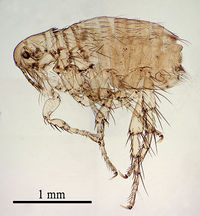Difference between revisions of "Ctenocephalides canis"
| (One intermediate revision by one other user not shown) | |||
| Line 1: | Line 1: | ||
| − | {{ | + | {{review}} |
| + | |||
Also known as: '''''Dog flea | Also known as: '''''Dog flea | ||
| Line 33: | Line 34: | ||
See [[Flea Life Cycle|general flea life cycle]]. | See [[Flea Life Cycle|general flea life cycle]]. | ||
| − | + | ==Literature Search== | |
| − | + | [[File:CABI logo.jpg|left|90px]] | |
| − | + | ||
| − | |||
| + | Use these links to find recent scientific publications via CAB Abstracts (log in required unless accessing from a subscribing organisation). | ||
| + | <br><br><br> | ||
| + | [http://www.cabdirect.org/search.html?rowId=1&options1=AND&q1=%22Ctenocephalides+canis%22&occuring1=title&rowId=2&options2=AND&q2=&occuring2=freetext&rowId=3&options3=AND&q3=&occuring3=freetext&x=67&y=11&publishedstart=yyyy&publishedend=yyyy&calendarInput=yyyy-mm-dd&la=any&it=any&show=all ''Ctenocephalides canis'' publications] | ||
| − | |||
[[Category:Dog Parasites]] | [[Category:Dog Parasites]] | ||
[[Category:Fleas]] | [[Category:Fleas]] | ||
[[Category:Expert_Review]] | [[Category:Expert_Review]] | ||
Revision as of 17:06, 14 December 2010
| This article has been peer reviewed but is awaiting expert review. If you would like to help with this, please see more information about expert reviewing. |
Also known as: Dog flea
| Ctenocephalides canis | |
|---|---|
| Class | Insecta |
| Order | Siphonaptera |
| Family | Pulicidae |
| Species | Ctenocephalides canis |
Hosts
Dogs, cats, rabbits, rats, foxes and humans
Identification
C. canis is very similar to C.felis, and of the order Siphonaptera. The first genal spine is 0.5 times the length of the second, and C. canis has a more rounded head than C. felis.
Life Cycle
Again, very similar to C. felis. The eggs are produced soon after arrival on the host. They then hatch into larvae, which undergo two moults before entering the pupae stage. The pupae may remain dormant for a year or longer, and are stimulated to hatch by mechanical stimuli such as vibrations.
Under suitable conditions, the complete life cycle can take as little as 3 weeks.
Literature Search
Use these links to find recent scientific publications via CAB Abstracts (log in required unless accessing from a subscribing organisation).
Ctenocephalides canis publications

